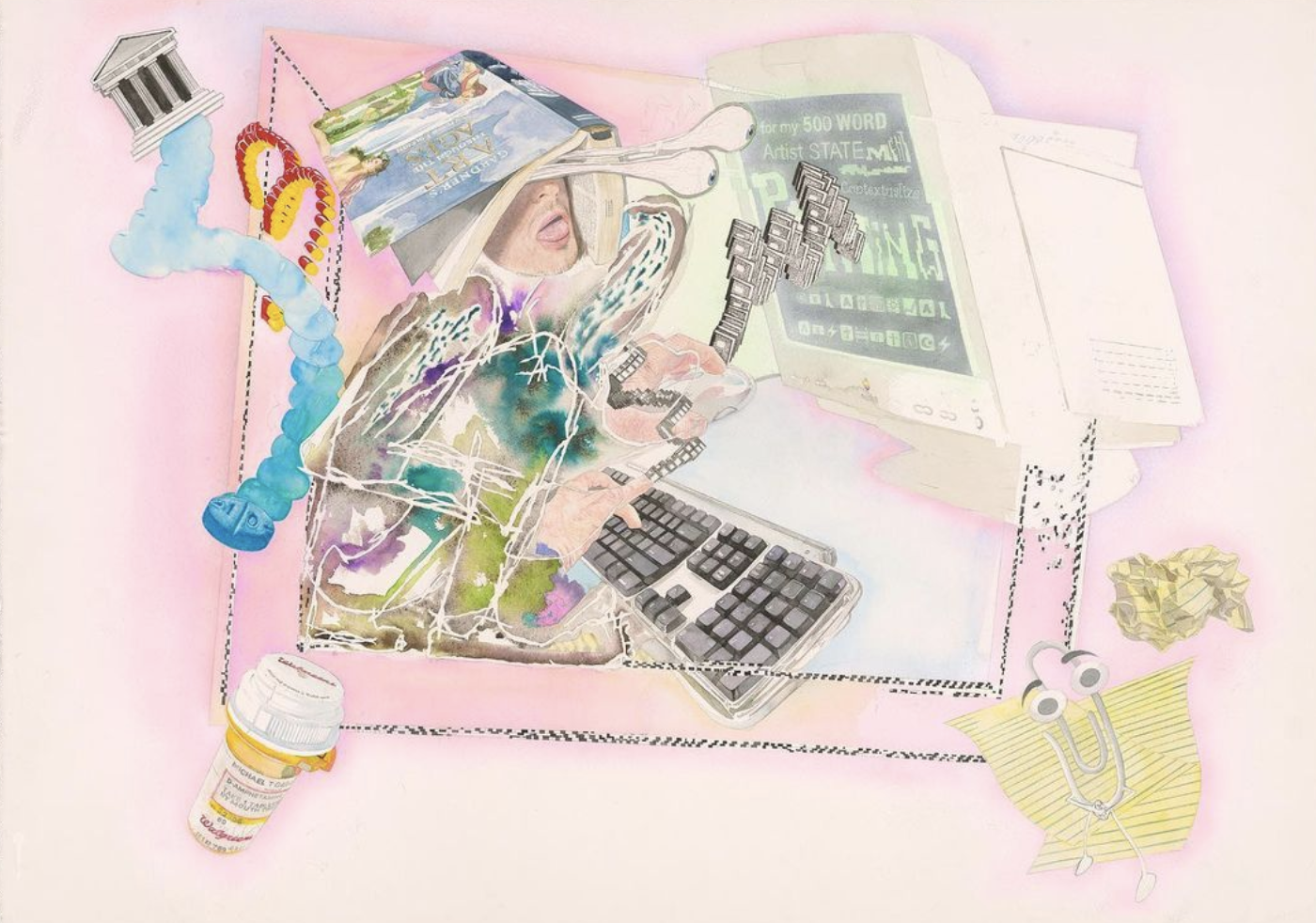Michael Gaughan’s art career spans over twenty years and his paintings are testament to the power of the medium. He’s completed countless projects within that time, including notable live performances, album artwork for popular musicians, and commercial branding—he’s even created a custom ceramic back-splash referencing Raphael’s School of Athens (1509) in his kitchen. There’s a whole overarching philosophy of life that underlies this exhibition, presenting itself as a radical interjection within the historic medium of watercolor. To describe this show would be to say that it is an exhibition of thought-provoking and imaginative works challenging traditional notions of art. The artwork encapsulates Gaughan’s playful and irreverent spirit, with each piece offering a fresh perspective on familiar subjects and themes. At the same time, viewers are invited to reflect on deeper questions about identity, perception, and the nature of creativity itself. Overall, “Creative Art Show” is a celebration of the human imagination and its boundless potential for innovation and self-expression.
Gaughan’s limitless creativity is evident and built on the exuberance of his own custom palette. Methodically working at his in-home studio, he challenges the boundaries that confine two-dimensional works of art. He asks himself: How can water-based media portray the illusion of motion or time without being animated? And furthermore, how fluid can one make that look? Watercolor paintings that seem effortless have a sense of energy and movement with colors blending and flowing together in a natural way. This creates a sense of atmosphere and mood that can be difficult to achieve through other mediums. When a watercolor painting looks effortless, it makes viewers feel as though they are looking at something captured in the moment, rather than something meticulously planned and executed. Similarly, a good joke keeps the same fleeting time signature. You’d never expect the amount of hours either takes to craft. Of course, achieving seamless effects in painting (and comedy) is not actually effortless. It requires a great deal of skill and practice to master the techniques in order to achieve the desired outcome. And when done well, it results in something utterly captivating.
A lot of planning goes into the final paintings on display. Breaking down his process, each piece starts as a thought. The thought is conveyed into a drawing on a piece of paper–this is Gaughan’s way of visually checking “if the idea works.” A successful sketch will elicit an immediate response. All reactions are acceptable, but for Gaughan there is a consistent genuine favor towards content that evokes laughter. He utilizes the comedic tactic of “punching-up1,” rather than the opposing idea of “punching down,” which relies on the controversial shock value of demeaning imagery. After approval, he scans the sketch onto his computer and subjects the drawing to a myriad of tools found within Adobe Photoshop. One cool fact about his process is that Gaughan has a long history of asking friends to pose for reference images which he layers over a sketch in Photoshop. This practice will not only help accurately render realism but also forms a deeper level of personal connection.
Gaughan’s artwork is characterized by an intermix of color and form. He expertly renders realism coupled with the emotional intensity of abstract expressionism. By subtly capturing interplays of light and shadow, he creates a profound sense of realistic depth in his paintings. This quality effectively underscores the sophomoric wit imbued within the content. Have you ever thought about what an apple would look like eating a Reese’s Peanut Butter Cup? (See An apple enjoying a Reese’s (2023)). Aside from being absurdly humorous, personifying objects reminds us of the power of creativity, to see beyond the literal, and imagine objects in new and unexpected ways. It reminds us of our own human quirks and foibles, as we recognize that the objects we personify often have exaggerated human traits we relate to, teaching us about the importance of imagination, empathy, and understanding. We connect to objects in a way that allows us to realize the needs and feelings of the object might not be too different from our own.
Gaughan finds a way to arouse emotion within relatable moments like being stuck in traffic, going to a wedding, or how someone spends their time in therapy. In the piece, For my 500 word artist statement (2023), Gaughan focuses on directly relating to artists. Writing an artist statement is commonly done when applying for various artistic opportunities. An artist’s statement is a general introduction to one’s entire body of work or a specific project. It is meant to enhance understanding. By today’s standards, acute writing skills are required to go into detail about one’s overall vision, medium and tools, influences, and techniques; which can be hard to clearly nail down without tangentially forming a manifesto. In addition to having a titular or educated quality, it also requires a certain degree of self-awareness to accurately describe what it is you’re doing. While performing certain tasks or following through with expectations may seem mundane and unexciting, Gaughan’s creative approach demonstrates that even seemingly tedious tasks can be transformed into something unique and fascinating.

Gaughan believes the world offers itself to imagination and that dreaming wildly is one of life’s greatest opportunities. In his practice, Gaughan doesn’t settle for just the accomplishment of technical ability. He takes his work a step further, into the unknown, to discover what happens when you question the boundaries of reality. Your imagination gives you the ability to conceive and reflect on multiple perspectives, scenarios, and the implications of these for one’s own and others’ lives. Creativity and imagination promote the understanding of multiplicities of identity, the experience within oneself and others, to reason ethically, and appreciate human diversity and potential. For creativity to happen, imaginative thought is infused into mental simulations that are regulated, evaluated, and integrated to conjure new ideas and concepts. Gaughan uses humor and imagination to create illustrious paintings which defy boundaries and limitations of expectation. “Creative Art Show” is but one part of Gaughan’s ongoing and relentless commitment to exploring and encouraging others to embrace their own unique output of creativity and imagination, whatever that may be.
XOXO KJ
